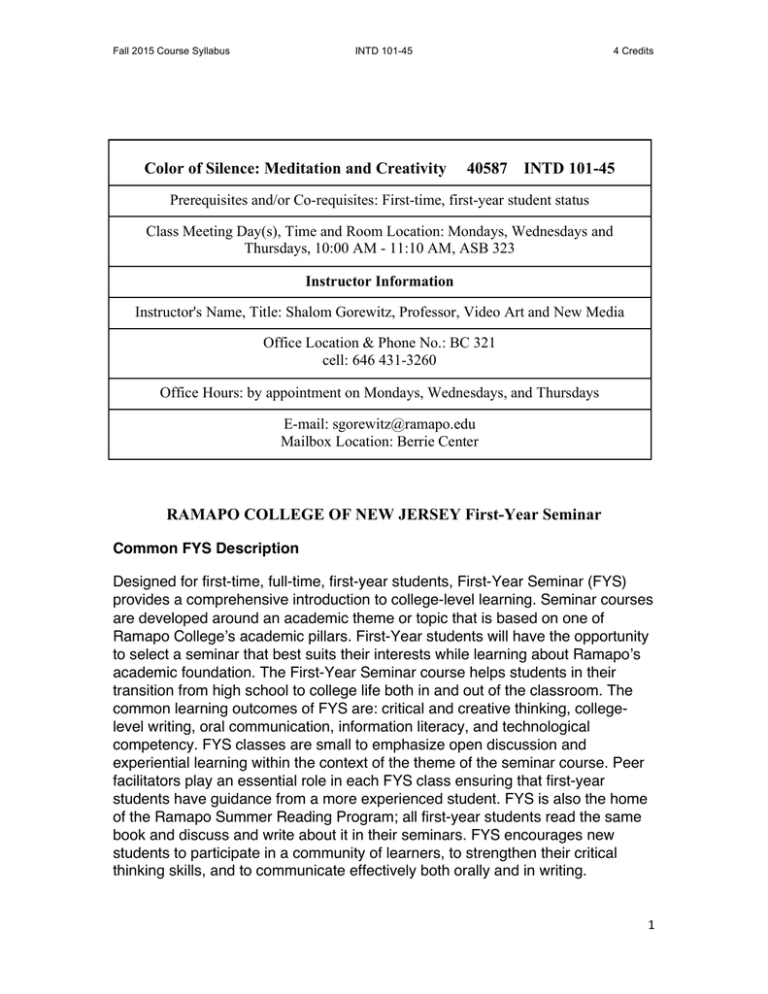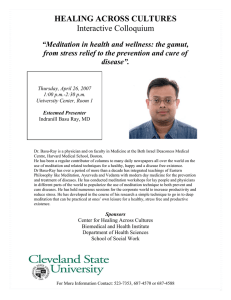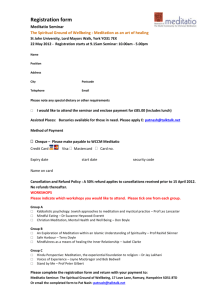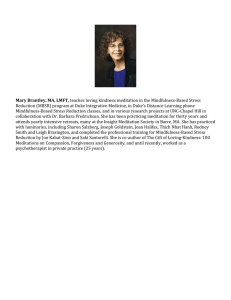Document 12145996
advertisement

Fall 2015 Course Syllabus 4 Credits INTD 101-45 Color of Silence: Meditation and Creativity 40587 INTD 101-45 Prerequisites and/or Co-requisites: First-time, first-year student status Class Meeting Day(s), Time and Room Location: Mondays, Wednesdays and Thursdays, 10:00 AM - 11:10 AM, ASB 323 Instructor Information Instructor's Name, Title: Shalom Gorewitz, Professor, Video Art and New Media Office Location & Phone No.: BC 321 cell: 646 431-3260 Office Hours: by appointment on Mondays, Wednesdays, and Thursdays E-mail: sgorewitz@ramapo.edu Mailbox Location: Berrie Center RAMAPO COLLEGE OF NEW JERSEY First-Year Seminar Common FYS Description Designed for first-time, full-time, first-year students, First-Year Seminar (FYS) provides a comprehensive introduction to college-level learning. Seminar courses are developed around an academic theme or topic that is based on one of Ramapo College’s academic pillars. First-Year students will have the opportunity to select a seminar that best suits their interests while learning about Ramapo’s academic foundation. The First-Year Seminar course helps students in their transition from high school to college life both in and out of the classroom. The common learning outcomes of FYS are: critical and creative thinking, collegelevel writing, oral communication, information literacy, and technological competency. FYS classes are small to emphasize open discussion and experiential learning within the context of the theme of the seminar course. Peer facilitators play an essential role in each FYS class ensuring that first-year students have guidance from a more experienced student. FYS is also the home of the Ramapo Summer Reading Program; all first-year students read the same book and discuss and write about it in their seminars. FYS encourages new students to participate in a community of learners, to strengthen their critical thinking skills, and to communicate effectively both orally and in writing. 1 Fall 2015 Course Syllabus INTD 101-45 4 Credits Course Description “Color is the keyboard, the eyes are the hammers, the soul is the piano with many strings. The artist is the hand which plays, touching one key or another, to cause vibrations in the soul.” - Wassily Kandinsky Contemplative Practice includes yoga, meditation, and mindfulness techniques that are scientifically proven to calm the mind, harmonize body and spirit, and support the learning process. This course provides an experiential, historical, and conceptual foundation for empirical investigation. Through actually using yoga and meditation techniques and then reflecting on them through research, writing, and discussions, the student experiences a holistic pedagogical approach while gaining some of the inherent benefits of the practice. Meditation practice dates back at least 1500 BCE when it is mentioned as an attentional method in the Rig Veda. Patanjali, a second century mystic defined meditation in the Yoga Sutras an a strategy leading to the cessation of movements in the consciousness which allows the practitioner to dwell in “true splendor.” Patanjali taught that meditation has four phases, withdrawal of external sense awareness; concentration; unbroken concentration; and absorption. Meditation involves conscious intention that is absorbed over time leading to an integration of a liberated mind with empirical consciousness. The Vijnana Bhairava has 112 devices of attention through mindfulness, concentrated attention, and combined strategies. More recently, popular and widely known Transcendental Meditation is based on a mantra, absence of concentrative effort, development of a thought free transcendental awareness. Mindfulness approaches to meditation, including Zen encourage detached nonjudgmental witnessing of thoughts, feelings, and sensations. Class sessions will include a variety of meditation and yoga techniques, sometimes taught by guests expert in specific approaches. Because Buddhism and Mindfulness Meditation are essentially non-deistic, they can be taught in secular and inclusive ways. The ancient sciences of the Vedic traditions are God oriented, but very practical and universalist in their approach to integration of mind/body/spirit. Through the scheduled meditations and guests, students will learn many techniques and approaches that can evolve over a life time of group and individual discipline. Meditations will be followed by a creative experience including color studies, eco-art, poetry writing, and digital (smartphone) photography. Students will organize their work in multi-disciplinary portfolios while contributing examples and/or copies of creative projects. All the projects will focus on the question the 2 Fall 2015 Course Syllabus 4 Credits INTD 101-45 title of the course raises: what is the color of silence? This serves as a semester-long koan for students to use as an object of contemplation, self reflection, and investigation. There is no right or wrong answer, but there is also no “final” or definitive answer either. There will be field trips to visit regional spiritual centers and museums. Previous classes have visited the Ruben Museum in Manhattan, which has one of the best collections of Himalayan Art; the Cloisters; and Museo de Barrio. During the semester several films will be screened during special evening sessions. Students are encouraged to practice a meditation or yoga technique of their own choice at least 3 times a week outside of class. Course Goals The seminar will support meditation practice, visual perception, art making, and understanding of nature through experiential and philosophical learning activities leading to deeper insights concerning sound, light, color, movement, and form. Students will learn meditation and art techniques and principles derived from Vedic, Buddhist, African, and Secular traditions. They will gain knowledge and learn skills in the interpretation and use of color for art, advertisements, and Outcomes Paper Discussions Art Projects Assignments X X Students will X understand the history of meditation x x Assigned research paper; will also be assessed through art projects. Students will develop creative skills in their selected media and disciplines. x x x Write about personal work and answer question: what is color of silence? Students will be able to articulate about meditation and artmaking experiences. x x Students will know several forms of meditation Students will learn how to integrate meditation skills into their lives. x Participate in meditations Report on how meditation effected art making and creative process x Reflection on how practices has or can change behavior and support improvements. 3 Fall 2015 Course Syllabus 4 Credits INTD 101-45 fashion. They will read essays, poems, and stories that support the thematic knowledge students will gain in this course. Students will see several excerpts from a variety of films that examine topics. Measurable Student Learning Outcomes Peer Facilitators As an added resource for first-year students, each section of First-Year Seminar (FYS) will have a peer facilitator. These upper-level students will attend FYS classes and assist the instructor with the academic topics covered in this seminar. They will serve as discussion leaders on issues that pertain to your personal and social development and they will facilitate weekly discussions on the class readings. Your peer facilitator will be your mentor and will be available to you to provide guidance on navigating the different personal and social hurdles that you may encounter in your first year at Ramapo. First-Year Academic Advising Each First-Year Seminar course is assigned a professional Academic Advisor from the Center for Academic Advising and First-Year Experience (CAAFYE) who serves as your Academic Advisor during your first year. This advisor will attend your First-Year Seminar class for a group advisement session to review general academic advising policies and procedures. They will also be available to answer any general questions regarding college policies/practices. Students are encouraged to schedule individual appointments with their CAAFYE Advisor for assistance with course selection and the development of a personal academic plan. If you have any questions regarding Academic Advisement please call CAAFYE at (201) 684-7441 or via Diana Hacker Rules for Writers Bedford/St. Martin's 978-0-312-64795-7 John Daido Loori Finding the Still Point (Book and CD): A Beginner's Guide to Zen Meditation (Dharma Communications) Shambhala 978-1590304792 John Daido Loori The Zen of Creativity: New York: Cultivating Your Artistic Life Ballantine Books 978-0345466334 Lao Tzu and Stephen Mitchell Tao Te Ching Frances Lincoln 978-0711229648 Shambhala 978-1590303801 Gil Fronsdal The Dhammapada: A New Translation of the Buddhist Classic with Annotations 4 Fall 2015 Course Syllabus INTD 101-45 4 Credits email at: caafye@ramapo.edu Texts, Readings, Materials Essays (To be provided) On Vision and Colors by Arthur Schopenhauer Color Sphere by Philipp Otto Runge The Figure a Poem Makes by Robert Frost Recommended Texts: Ball, Philip (2001)Bright Earth: Art and the Invention of Color. New York: Farrar, Strauss and Giroux. ISBN 0-374-11679-2 Finley, Victoria (2002). Color: A Natural History of the Palette. New York: Random House Trade Paperback Edition. ISBN 0-8129-7142-6 Wittgenstein, Ludwig (1950). Remarks on Colour. Berkeley: University of California Press. ISBN 9-780520-251793 Kandinsky, Wassily (1914). Concerning the Spiritual in Art. MFA Publications ISBN 978-0878467020 Theroux, Alexander (1994).The Primary Colors. New York: Henry Holt and Company Owl Book Edition. ISBN 9-780805-047011 Theroux, Alexander (1996). The Secondary Colors. New York: Henry Holt and Company Owl Book Edition. ISBN 9-780805-053265 Batchelor, David (2000). Chromophobia. London: Reaktion Books LTD. ISBN 978-1-86189-074-0 More recommended books The Chakras by Janet Boyer Spirituality in Contemporary Art: The Idea of the Numinous by Jungu Yoon Spirit Taking Form: Making a Spiritual Practice of Making Art by Nancy Azara Windows into the Soul: Art as Spiritual Expression by Michael Sullivan Theory of Colours by Johann Wolfgang von Goethe Colour by Rudolf Steiner How to Heal with Color by Ted Andrews Interaction of Color: 50th Anniversary Edition by Josef Albers Course Requirements 5 Fall 2015 Course Syllabus INTD 101-45 4 Credits Classroom Participation – If you are uncomfortable with the idea of meditation in traditions other than your own, please reconsider taking this FYS. In contrast to your other classes you will be evaluated on how well you can sit still and remain quiet. Meditation is simultaneously a group and an individual experience. Your participation involves deep self-study and possibly experiences of calmness and energy that will be conveyed through the intentions and merits of your sitting and art making practices. Your expectations regarding students’ involvement in the conduct and tasks of the course should be made clear. Writing Assignments All assignments should have your name and contact information, date, and include page numbers. Pages can be single or double spaced. You are welcome to use small images to illustrate your writing. Informal citations, in parenthesis after a quotation or paraphrase of someone else’s ideas, are sufficient. Please give credit. It’s fine to quote, not to claim someone else’s ideas as your own. 1. 2. 3. 4. One page, spiritual autobiography. Two pages, family history. Three pages, research paper about personal spiritual path. Four pages, select one of the required books and at least one other required or recommended books and write a review focused on those books. 5. One page, review of movie screened for class or about visiting teachers. 6. One page, summary of course 7. 14 page compilation of 1-6 creating threads that join the narrative into one continuous long essay about the experience of the materials and activities of the class. Examinations, Laboratory/Studio, Library Research – Research oriented writing assignments should reflect Library as well as on-line resources. There will be studio time for a variety of projects. Disciplined studio work requires and your grade will be based on serious intention; focus; and intense quiet. General Education Program Course This course fulfills the First-Year Seminar category of the general education curriculum at Ramapo College. Common to all First-Year Seminar (FYS) courses, you will develop critical thinking skills that are basic to college level study, regardless of your area of interest. You will be reading, writing, and participating in thoughtful group discussions with the aim of developing the skills of a scholar. You will learn to support your arguments using a foundation of 6 Fall 2015 Course Syllabus INTD 101-45 4 Credits knowledge and facts rather than simply using personal opinions and experiences. This course fulfills experiential learning, interdisciplinary studies, international education, intercultural understanding, and sustainability, areas that are considered the pillars of a liberal arts education at Ramapo College. Meditation and art making are empirically experiential; studied together in historical and sociological contexts; and linked through ancient, non-western techniques. Writing Intensive (WI) Course Writing will be integrated into the life of this course. You will receive comments, direction, and support as you work on strengthening your writing skills. Your writing will be evaluated and returned in a timely fashion, allowing you to incorporate my comments into your future work. For help outside the classroom, please see me during my office hours and/or work with a writing tutor in the Center for Reading and Writing (CRW), Room: L-211, x7557, crw@ramapo.edu. Weekly Class Schedule Date Class topic, reading assignment st September 1 Opening Convocation, Phil Klay, author of Redeployment Week 1 Basic Meditation; Basic Studio; Peer Week 2 Basic Meditation; Color Studies; Peer Week 3 Visualization Meditation; Library Visit; Peer Week 4 Visualization Meditation; Visit Hindu Temple; Peer Week 5 Walking Meditation; Color of the Divine; Academic Advisement Week 6 Movement Meditation; Color Photography; Academic Performance Review Week 7 Ta’i Chi; Digital Film; Advisement/Course Registration Review Week 8 Ch’i Gong; Digital Film; Service Learning 7 Fall 2015 Course Syllabus Week 9 Modern Dance all week Week 10 African Meditation; Studio Sessions; Peer Week 11 Native American Meditation; Service Learning Week 12 4 Credits INTD 101-45 th Thanksgiving recess (Wednesday, November 25 to Saturday, th November 29 ) Week 13 Student led meditations; complete projects; peer Week 14 Student led meditation; project critiques; peer Week 15 Student led meditation; project critiques; peer Final Exam Objective Exam on Meditation Terms and Concepts nd Important First Day ofDates Classes: September 2 th Last day for Schedule Adjustments (on the Web): September 9 th Last day to withdraw from courses with “W” grade: November 13 th th Thanksgiving Recess: Nov 25 – 29 th Reading Day (no classes): December 15 th nd Final Exam Week: December 16 – 22 th Common Finals: December 19 nd Last day to request “I” grades: December 22 rd Final Exam Snow Make-Up Day: December 23 Grading Policy • Writing Assignments 50 • Meditation Practice 20 • Art Practice 20 • Final Exam 10 • Meditation practice will be assessed based teacher’s observation of disciplined approach including straight spine, relaxed neck and shoulders, and silence. Students will be evaluated based on the quality of their questions and responses to various techniques. • Art practice will be evaluated based on student application of color, wave, light, and other elements of art in relationship to the specific assignment and the 8 Fall 2015 Course Syllabus 4 Credits INTD 101-45 general question that underlies all of the work: What is the color of silence? • Final Exam will include objective, multiple choice questions based on readings. • Writing will be assessed for clarity and focus of writing, formal presentation, and content. • If you require an Incomplete, please notify me as quickly as possible before the end of the semester. Grade Distribution A A- B+ 100-95 95-91 90-87 B B- C+ C C- D+ D F 86-84 83-81 80-78 77-75 74-70 69-66 65-61 60 Criteria for Evaluation of Writing Project 9-10 points- Makes fulfillment of the task a creative expression. Writing reflects excellent application of skills in critical analysis, interpretation, and judgment. Experiential report and research essay show extensive use and understanding of terms from the art glossary and visual art vocabulary. Comments, metaphors, and descriptive language are insightful and based on careful analysis. Interpretation reflects knowledge and makes relevant references to history and popular culture. Critical observation of the work is clearly stated and is based on descriptive examples. The reader gains a clear picture of the artist, film, exhibit and an understanding of the writer’s point of view. 7-8 points- Completes the task in an incisive and thorough manner. Writing reflects skill in critical analysis, interpretation, and judgment. Student uses terms from the art glossary and vocabulary list, as well as metaphors or descriptive language. References are made to related works from the history of art. Critical judgments are clear and reader gains an insight into the work or event. 5-6 points- Substantially completes the task, with some ideas or concepts missing. The writer includes analysis interpretation, and critical judgment. Some terms from the art glossary and vocabulary list are used. At least one reference is made to related work from history and popular culture. The writer's opinion is stated, and the reader gains a basic understanding of the artwork, film or event. 9 Fall 2015 Course Syllabus INTD 101-45 4 Credits 3-4 points- Partially completes the task with minimal or perfunctory effort. There is an attempt to include analysis interpretation, and critical judgment in the review. A few terms from the art glossary and vocabulary list are used. A reference to work from the history of art may be included, but the connection to the work being reviewed may not be clear. The writer takes a position on the work, but it is not strongly substantiated. There is an attempt to describe the work or event, but the reader may not gain a clear picture. 2 points- Minimally completes the task with fragmented results--may need redirection in the future. Use of analysis, interpretation, and critical judgment may be evident, but not clearly exhibited. Few, if any, terms from the art glossary or vocabulary list are used. No references are made to relate works from the history of art. If one is used, it is not relevant. The writer does not make his or her opinion regarding the exhibit, film or event clear, and it is not based on stated observations. It is difficult for the reader to gain an idea of what the exhibit or event was like. 1 point- Shows little evidence of having attempted to accomplish the task. The text does not go through the steps of analysis, interpretation, and judgment, nor does it contain any terms or vocabulary. The reader gains no understanding of the artist, exhibit or event or of what the writer based an opinion on. Attendance Policy • In order to learn the various techniques and participate in the different parts of the seminar, students are encouraged to attend every class on time. There are circumstances that can’t be avoided and I will be sympathetic to the realities of your lives. “College policy states that students must notify faculty within the first three weeks of the semester if they anticipate missing any classes due to religious observance.” Electronic Forms of Communication In accordance with College policy, I will use your Ramapo College email address (@ramapo.edu) to communicate with you about all course-related matters. Students with Disabilities “If you need course adaptation or accommodations because of a disability that has been documented with the Office of Specialized Services, please make an appointment with me.” 10 Fall 2015 Course Syllabus INTD 101-45 4 Credits Students must be registered with the Office of Specialized Services (OSS) to receive accommodations. For additional information, contact the Office of Specialized Services (OSS) at x7514 or email at oss@ramapo.edu. Academic Integrity Policy All members of the community are expected to be honest and forthright in their academic endeavors. Since violations of academic integrity erode community confidence and undermine the pursuit of truth and knowledge at the College, academic dishonesty must be avoided. Procedure Responsibilities The Office of the Provost has responsibility for the oversight and enforcement of the Academic Integrity Policy and for making the policy an institutional priority. The Office of the Provost is also responsible for publishing the policy and for educating both faculty and students about the policy. Faculty members play a crucial role in the Academic Integrity Policy. They are responsible for educating their students about the importance of academic integrity and for communicating to students their expectations with respect to academic integrity in course work. They are also urged to report alleged violations of the policy to the Vice Provost. Students have the responsibility to understand the Academic Integrity Policy and to comply with the policy in their academic work. Criteria There are four (4) broad forms of academic dishonesty: 1. Cheating Cheating is an act of deception by which a student misrepresents his or her mastery of material on a test or other academic exercise. Examples of cheating include, but are not limited to: o copying from another student’s work; o allowing another student to copy his/her work; o using unauthorized materials such as a textbook, notebook, or electronic devices during an examination; o using specifically prepared materials, such as notes written on clothing or other unauthorized notes, formula lists, etc., during an examination; 11 Fall 2015 Course Syllabus INTD 101-45 4 Credits o collaborating with another person during an examination by giving or receiving information without authorization from the instructor; o taking a test for another person or asking or allowing another to take the student’s own test. 2. Plagiarism Plagiarism occurs when a person represents someone else’s words, ideas, phrases, sentences, or data as one’s own work. When a student submits work that includes such material, the source of that information must be acknowledged through complete, accurate, and specific footnote or endnote references; additionally, verbatim statements must be acknowledged through quotation marks. To avoid a charge of plagiarism, a student should be sure to include an acknowledgment of indebtedness: o whenever he or she quotes another person’s words directly; o whenever he or she uses another person’s ideas, opinions, or theories, even if they have been completely paraphrased in one’s own words; o whenever he or she allows another individual to contribute to the work in some significant fashion (for instance, through editing or sharing of ideas); o whenever he or she uses facts, statistics, or other illustrative material taken from a source, unless the information is common knowledge. Examples of standard citation formats can be found on the George T. Potter Library Website: Library Website: Citation Manuals and Style Guides 3. Academic Misconduct Academic misconduct includes the alteration of grades, involvement in the acquisition or distribution of unadministered tests, and the unauthorized submission of student work in more than one class. Examples of academic misconduct include, but are not limited to: o changing, altering, falsifying, or being the accessory to the changing, altering, or falsifying of a grade report or form, transcript, or other academic record, or entering any computer system or College office or building for that purpose; o stealing, buying, selling, giving way, or otherwise obtaining all or part of any unadministered test or paper or entering any computer system or College office or building for the purpose of obtaining an unadministered test; 12 Fall 2015 Course Syllabus INTD 101-45 4 Credits o submitting written work (in whole or in significant part) to fulfill the requirements of more than one course without the explicit permission of both instructors; o disregarding policies governing the use of human subjects or animals in research; o sabotaging another student’s work through actions designed to prevent the student from successfully completing an assignment; o knowingly facilitating a violation of the academic integrity policy by another person. 4. Fabrication Fabrication refers to the deliberate use of invented information or the falsification of research or other findings with the intent to deceive. Examples of fabrication include, but are not limited to: o citing information not taken from the source indicated; o citing of sources in a “works cited” that were not used in that project; o altering, stealing, and/or falsifying research data used in research reports, theses, or dissertations; o submitting as one’s own any academic work prepared in whole or in part by others, including the use of another’s identity; o falsifying information or signatures on registration, withdrawal, or other academic forms and records. Reporting Violations In order to ensure due process, any member of the community who is aware of a violation of the Academic Integrity Policy is expected to report the incident to the Vice Provost. A faculty member may choose to resolve the incident him/herself or send the case to the Vice Provost for review (see below). In either case, the faculty member reports the incident to the Vice Provost on the reporting form, which serves not only to report the incident but also to record the finding and the sanction in situations in which the faculty member chooses to resolve the case. A faculty member is encouraged to report an alleged violation of academic integrity within 30 days of the discovery of the alleged violation but must do so no later than the last day to submit grades for the term in which the alleged violation occurred. A faculty member may report an incident after that date, but only if he/she has new evidence. More details on Ramapo College’s academic integrity policy can be found here: http://www.ramapo.edu/catalog-2015-2016/academic-policies/ 13




